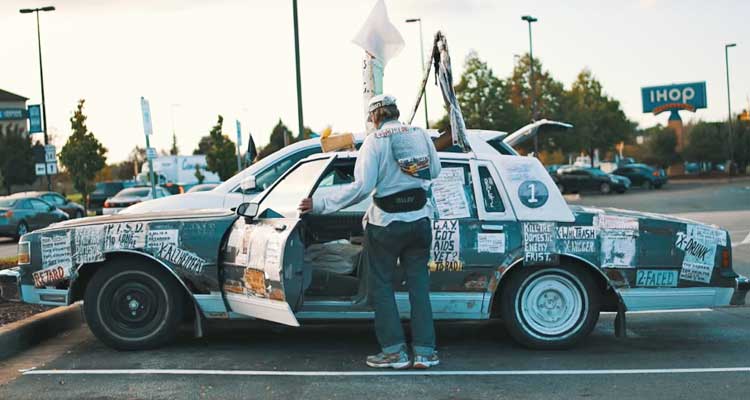If you’ve lived in Milwaukee for longer than 30 seconds, you’ve likely spotted “Brother Ron” and his sign-covered “Jesus Car.” Yes, Ronald C. Stanis has been cruising the Milwaukee streets for approximately 35 years now, confusing onlookers, blaring some crazy shit from speaker on top of his car, and netting his fair share of Instagram photos. Easy to overlook, however, is the man’s message, which is strictly of the hate-filled, Book of Revelations-laden variety. That dichotomy—”Brother Ron” the local character, and “Brother Ron” the toxic street preacher—is explored in a new short film called Milwaukee Icon.
Shot and directed by Milwaukee filmmaker Tyler Pelzek, the five-minute film consists solely of footage of Ron on his daily downtown drive, and cellphone audio of the man describing his life and mission. It’s a smart tactic that allows Ron to dig his own hole, so to speak (“Yeah, I used to take it personally. To the point where I would grab their bottle, break it, pull the cigarette out of their mouths, run the whore off the corner,”) and earn just a wee bit of sympathy (“It used to be every day. It used to be eight in the morning ’til eight at night or longer. But as you get older, you just kind of slow down, like everybody else does.”)
Watch the film below, and read a short essay from Pelzek on the making of the film below that.
I initially set off to make a film about cultural identity. More specifically, I wanted to more fully understand the “cultural outcast” mindset and lifestyle. Individuals that live and breathe by their own personalized set of values have always inspired me to take a critical look at my own identity.
Ronald “Brother Ron” Stanis is the epitome of that mindset in the context of my own life. I have fractured but striking memories of his car that date back to my early childhood. Reflecting on those memories, I made the realization that my child mind retained nothing of the signs themselves, and nothing specific of the blaring speeches. I remember only feeling an unparalleled aura of hate. It was only recently that I, at 17, began to question those preconceptions.
For as many times as I had witnessed the surrealism that is Brother Ron’s Jesus mobile, I lacked any specific knowledge as to what it was that was being preached. I can say with conviction that, rather than educating myself on the specifics of his signs, I would constantly dismiss him as “the crazy car guy.” It came to my knowledge soon thereafter that so many people in Milwaukee were keeping themselves in the same darkness that I had been. For whatever reason, we were allowing for his strangeness to dilute his shocking, and often dangerous, messages. I wanted to learn what it was that inspired such a radical form of expression, and why such a life-altering response was necessary.
I found his phone number hidden on a sign in and old photograph of one of his previous cars. I contacted him, briefly explained my need for answers, and he agreed to meet me the following day. We met at his “office,” a McDonald’s on 43rd and National, which became the only portal I would ever have into his life. Outside of his “office,” he warned me, there would be no discussion of his personal life.
Our first meeting was nothing short of surreal. Seeing his face for the first time, I felt an almost overpowering wave of anxiety. The table that he had decided to make his desk for the day had been transformed into a pop-up shop of shocking signs. At one point during our meeting, a random mailman arrived and sat, uninvited, across from Brother Ron, silently nodding along to his statements. I learned later that the mysterious postal-service worker was a regular attendee of Brother Ron’s makeshift masses. I would meet several other “followers” over the next several days.
I never stopped feeling uneasy. No meeting would ever go as planned. It took days for me to get permission to film his face. I learned that he, despite being very vocal and transparent, is paranoid of exploitation. Our last meeting, which would have been the formal, recorded interview, was shut down. I waited for two hours at that McDonald’s, but Brother Ron never showed up. It wasn’t until later that week, when I finally got ahold of him for one last phone call, that I got the answers I needed. As I suspected, his paranoia had overcome him. He didn’t trust me, and that’s okay.
As serendipitously as I had been let into Brother Ron’s life, I was kicked out. It was the best thing that could have happened, I think. I began the project with a very predictable mindset. I thought I would end up interviewing, filming, and hating him. I wasn’t prepared to understand him.
It would have been easy to paint a picture with my film in which Brother Ron is portrayed as a villain. I realized, though, that art is ineffective if it doesn’t force people to reconsider preexisting notions. Though I, and many others, will persist to disagree with his messages, we can take this opportunity to learn exactly what he stands for. It’s hard not to respect his persistence. He genuinely believes in what he does, and perhaps doesn’t understand the risk of his words on others.

